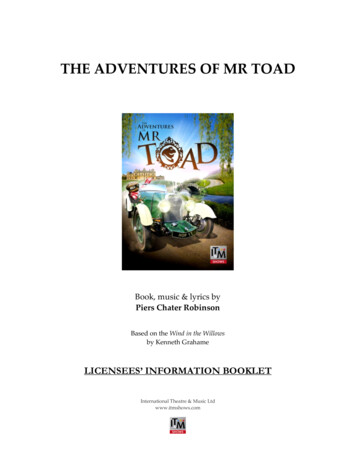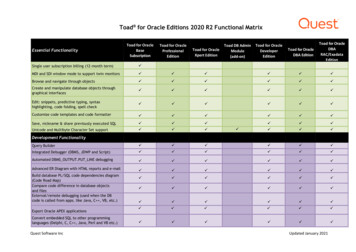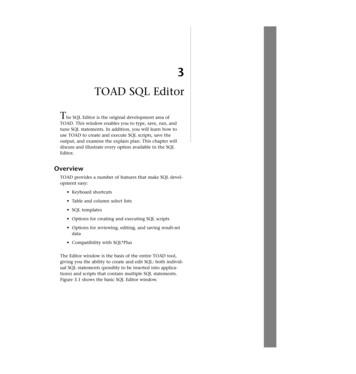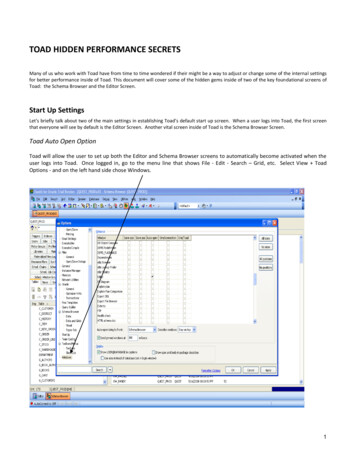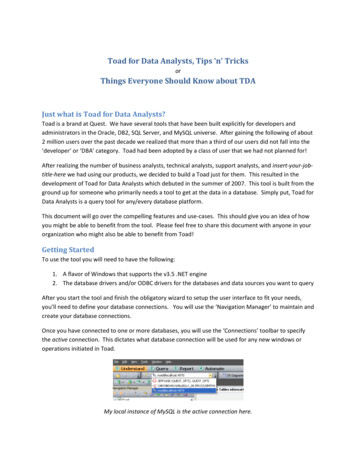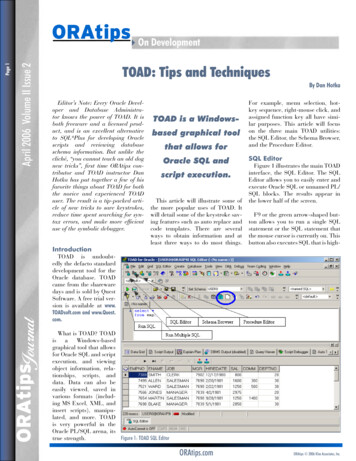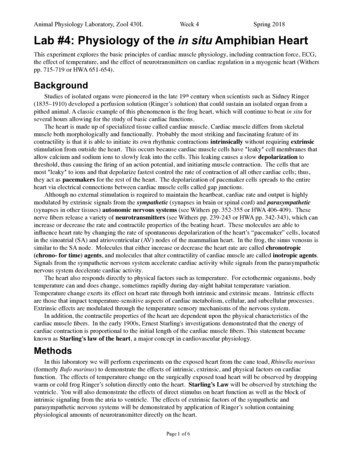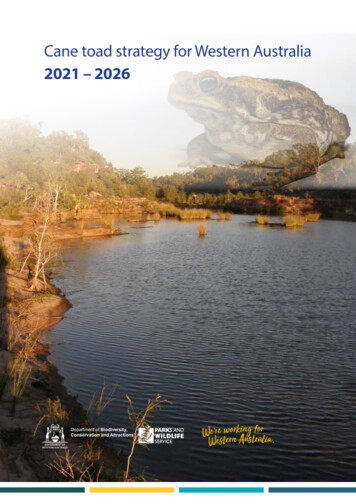
Transcription
Cane toad strategy for Western Australia2021 – 2026
Foreword from the Western Australian Minister for EnvironmentCane toads have been in Western Australia since 2009 when they crossed the border from the NorthernTerritory and began to make their way across the Kimberley region. A declared pest, cane toads are toxicwhen consumed and have direct and indirect impacts on the ecosystems they invade. The Department ofBiodiversity, Conservation and Attractions (DBCA) is committed to reducing the impact of this toxic invaderon the wildlife of Western Australia.Under previous Cane Toad Strategies for WA, considerable progress has been made towards maximising theunderstanding of cane toads, their impacts and management options and this knowledge has been usedto develop strategies to minimise the toads’ impact. Significant advancements were made in collaborativeresearch and DBCA has played a key role in the Cane Toad Coalition, a group of research, conservation andland management organisations working towards the largest toad mitigation strategy in Australia to date teaching native predators not to eat the toxic cane toad.Over this time, DBCA’s field-based cane toad surveillance and response team has successfully responded toand resolved ‘hitch hiker’ toad incidents across the State; created innovative communication andeducation channels, including a comprehensive schools education program across the State; and engagedthe community in toad musters to collect the toad meat needed for on-ground conservation research.DBCA staff worked with Aboriginal ranger groups throughout the Kimberley to collect importantinformation on native species ahead of the cane toad front and establish a long-term monitoring program.With the momentum, relationships and knowledge gained under the previous strategy it is timely to reviewand refocus efforts. The Cane Toad Strategy for WA 2021-2026 will ensure the management of cane toads inWestern Australia continues to adapt to the most recent advancements in knowledge and technology, withcontinued collaboration with traditional owners, research partners and stakeholders a primary focus.The updated strategy also highlights the ongoing value of education and communication programs to keepthe community involved and informed.2
ScopeThe Cane Toad Strategy 2021 – 2026 applies across WesternAustralia to guide research, planning and operations related to canetoad management.BackgroundCane toads (Rhinella marina), native to south and central Americawere deliberately introduced into Australia during the 1930s tocontrol sugar cane beetles in North Queensland cane plantations.Since their introduction, cane toads spread, both naturally and withhuman assistance, through Queensland, the Northern Territory andinto New South Wales and Western Australia, impacting bothdirectly and indirectly on native wildlife and ecosystems.Cane toad impacts on native species include: Poisoning through ingestion; Predation; Competition for habitat and food, and changing ecosystems through disrupting predator preyrelationships.The movement of the invading cane toad front has increased in pace over time, with the Western Australianfront now moving at an average rate of 50 kilometres a year depending on the topography, and seasonalconditions (most importantly when and how much rainfall occurs during the wet season).The cane toad is currently listed by the International Union for Conservation of Nature (IUCN) as one of theworld’s worst 100 invasive species. In 2005 the biological effect of cane toads was listed as a key threateningprocess under the Australian Environment Protection and Biodiversity Conservation Act 1999, highlightingthe impact this species has had on the Australian environment since its introduction in 1935. The AustralianGovernment provided national guidance on the threat of this species with the 2011 ‘Threat abatement planfor the biological effects, including lethal toxic ingestion caused by cane toads’, shifting, the national focusfrom stopping or slowing the spread of the toad to mitigating the impacts. Cane toads are a declaredspecies below the 26th parallel in Western Australia under the state’s Biosecurity and AgricultureManagement Act 2007.The initial State Government and community response in Western Australia focussed on trying to stop canetoads entering the State. Despite best efforts, cane toads crossed the Western Australian border in 2009 andthe focus moved to gathering further information on biological assets in the Kimberley, education,surveillance, and quarantine.Some actions in the previous strategies are continuing to work well and have been retained, some havebeen successfully completed, while others have been modified in response to scientific findings. Programachievements under the previous strategy can be viewed at appendix one.3
ObjectivesThe Cane Toad Strategy 2021-2026 will focus on mitigating the impact of cane toads and preventing canetoads from establishing satellite populations, education, and further research, through three objectives.Objective 1: Mitigate the impact of cane toads.Objective 2: Address knowledge gaps through scientific investigation.Objective 3: Collaborate and communicate.
The Cane Toad Program for Western Australia will be guided by: Research, monitoring and evaluation of cane toad and native fauna distributions. Innovativemanagement approaches are necessary to facilitate improvements in management over time within anadaptive framework. Taking effective action by using scientific information and best practice techniques to protect nativewildlife and natural environments from cane toads. Collaborative partnerships are vital, particularly with traditional owners, to ensure a continued sharedcommitment to effective cane toad management. Integration of cane toad management with other land management activities, including the Commonwealth’s Cane Toad Threat Abatement Plan (2011), ‘working on country’ plans for Indigenous ProtectedAreas, and DBCA’s management of parks and reserves and biodiversity assets. Public awareness and knowledge of cane toads and their impacts must be continually improved toensure effective communication methods are used and broader community awareness is achieved.DBCA’s Cane Toad Program is primarily responsible for implementing the actions in this strategy but willactively seek to collaborate and form partnerships with a range of organisations to be effective.5
Objective ActionsOutput/OutcomeUndertake biological surveys toidentify/refine knowledge of high valuebiodiversity assets/populations underthreat from cane toads.Information from biological surveys undertakenacross the Kimberley.Map potential locations for targetedconservation programs (includingnorthern quoll, goanna, and freshwatercrocodile).Map of high value biodiversity assets/populations of vulnerable species.Identify ways to improve mapping ofcurrent cane toad front to inform andadapt mitigation activities.Map the cane toad frontline annually andpublish on the DBCA website.Monitor changes in populations ofnative species at risk before and afterarrival of cane toads.Report published that documents changesobserved in native species populations at longterm monitored sites.Undertake mitigation activities toprotect identified species.List and map all sites where mitigation activitieshave been undertaken and publish in DBCA’sannual report.Work collaboratively to eradicate anyindividual or small groups of cane toadsdiscovered more than 50km ahead ofthe main front, where feasible.Report published on actions taken to follow upon isolated populations.Review and deliver quarantineprocedures post hitchhiker cane toadincidents.Updated surveillance standard operatingprocedure available.Maintain database to record each incident.Updated quarantine protocol for tourism, freightetc to cane toad free areas.6Regularly review and produce publicinformation aimed at minimising theaccidental movement of cane toads.Catalogue of information brochures available forvarious groups including tourism and transportindustries.Facilitate toad musters when feasibleand/or promote community cane toadcollection to contribute to conditionedtaste aversion projects.Produce cane toad taste aversion sausages fromtoad meat collected in toad musters.
Objective ActionsPartner with Aboriginal ranger groupsto manage cane toads.Output/OutcomeUpdated ranger handbook.Positive relationships with ranger groups aheadof the cane toad front.Support for ranger training programs.Align actions with the CommonwealthCane Toad Threat Abatement Plan (TAP)(2011).Identify, undertake and document TAPactions that Western Australia contributes toand report as required.Communicate and collaborate towardsthe implementation of islandbiosecurity measures to preventintroduction and establisment of canetoads.Update Kimberley Islands BiosecurityDiscussion Paper.Prepare and implement communication planand develop resources.Stakeholders understand their biosecurityresponsibilities and available management actions.Publish cane toad related monitoringresults and outcomes of researchprojects, including peer reviewedpublications.Publish peer reviewed reports on researchwhere possible.Updated information on DBCA website on theoutcomes of research projects.Stakeholders updated through appropriatechannels.Identify areas in the Pilbara regionwhere cane toads could potentiallybecome established and investigatemanagement options.Landscape scale mapping of areas in thePilbara susceptible to toad invasion and theirpersistence.Investigate the application of newcontrol methods for cane toads in thefield.List of methods investigated and thefeasibility of each method documented.Evaluate methods to protectbiodiversity assets from cane toadsthrough exclusion.Investigate knowledge gaps that underpinsuccess or otherwise of exclusion concepts.Collaborate with research institutionsto investigate alternatives inmitigation activities and othermanagement strategies.Productive working relationships withresearchers.Ensure cane toad managementstrategies developed by DBCA areavailable to the broader community.Cane toad project communications planpublished.Provide cane toad information for stakeholders.Standard operating procedures developed forfeasible methods.Updated information packages available atranger stations and other key locations.Surveillance standard operating procedure(including options for island surveillance) andother toad management standard operatingprocedures are produced and circulated.
Objective ActionsPromote humane methods of canetoad euthanasia and disposal.Output/OutcomeUpdated euthanasia and disposal standardoperating procedures published.Humane euthanasia methods communicatedvia website, social media and directcommunications.Deliver education and information oncane toads and their management.Educational resources and presentationsdelivered to communities ahead of the canetoad frontline in preparation for cane toadarrival.School-based cane toad education programrolled out throughout the State.Updated online resources.Evaluation and ReportingThis strategy will be annually reviewed, and progress checked against the outputs listed for each action.A report will be produced annually and made available on the DBCA website.8
Appendix 1 – Achievements under previous strategyThe Cane Toad Strategy 2014 – 2019 has delivered positive outputs and collaborations on several researchprojects under Australian Research Council grants and partnerships with universities. By supportingeffective quarantine strategies, investing in new research projects, and engaging with the community,DBCA has continued to improve the delivery of actions to mitigate the impact of cane toads. In the last tenyears, significant collaborative research has been carried out including: Conditioned taste aversion (CTA) training of northern quolls using CTA sausages. CTA occurs when ananimal (northern quoll) associates the smell and taste of an animal (cane toad) with sickness. The processinvolves making sausages baits from cane toad meat and adding a nausea inducing chemical to invoke anegative reaction when eaten. Teacher toads (metamorph cane toads with minimal toxin) have been released during landscape scale trialsin areas of high goanna abundance. This research has found that goannas are able to learn to avoid canetoads through taste aversion training. Pre-toad and post-toad arrival monitoring has shown that tasteaversion strategies have resulted in higher persistence of some goanna species after the arrival of canetoads. Investigations with support from the Department, into the use of pheromones extracted from cane toadtoxin, to attract cane toad tadpoles to traps and interrupt cane toad metamorphosis. Monitoring the long-term impact of toads on the fauna of Adolphus Island, including one of the lastremaining populations of northern quolls in the east Kimberley. Cane toads arrived on the island in 2014.DBCA has been monitoring the ongoing survival of quolls and other susceptible reptile species to determinelong-term survival of these species in the presence of cane toads. This information will help predict theimpact and survival of cane toads on other Kimberley islands and so inform possible management options. Toad drop-off boxes have been installed in numerous locations in the Kimberley to aid communitytoad-musters and have provided an important source for collecting cane toad meat for CTA baits. Large community toad-musters have been organised, engaging the help of local communityorganisations, Aboriginal ranger groups and individuals across the Kimberley to collect thousands ofcane toads required for CTA bait production. DBCA in collaboration with Rangelands NRM, Balanggarra Aboriginal Corporation and University ofSydney has progressed a range of actions funded through the Commonwealth Landcare program.This included the development of a ranger handbook, continuation of the goanna teacher-toadresearch and the delivery of the monitoring program on Adolphus Island.2021 134 -1121- PDF Online information and brochures have been produced and modified according to community needswith education packages republished and presentations updated and delivered to school groups andother organisations. Regular social media posts about cane toad issues are provided to the community,together with a cane toad reporting line for suspected hitchhiker cane toads.9
The cane toad is currently listed by the International Union for Conservation of Nature (IUCN) as one of the world's worst 100 invasive species. In 2005 the biological effect of cane toads was listed as a key threatening process under the Australian Environment Protection and Biodiversity Conservation Act 1999, highlighting
